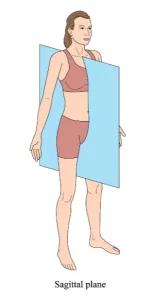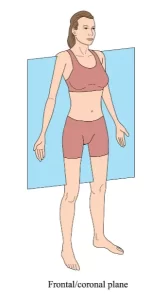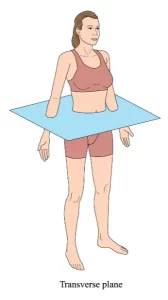Today, we’re going to have a chat about the three planes of human motion. Why? Because no one seems to train them even though they are a vital part of everything you do.
If you have been injured it is your avoidance of at least one of these planes that has led to your injury. Every sport uses all of them, every manual labour task uses them and you can’t even walk down the street without using every single one.
But you NEVER train one of these planes and I doubt you’ve even noticed!
There are three planes of motion that make up all human movement. These planes are the sagittal, frontal, and transverse planes and here is a short description of what each is:
 Sagittal Plane
Sagittal PlanePicture an imaginary line slicing you into left and right halves – that’s the sagittal plane. It lets us do all sorts of forward and backward movements.
Real World Movement: Walking and running are prime examples of sagittal plane action. Visualise the way your arms and legs swing back and forth with every step.
Gym Exercise: Lunges, squats, deadlifts, bench press, lat pull down, sit up…..basically everything you might have done in the past or are doing now.
 Frontal Plane
Frontal PlaneNow imagine a line cutting you into front and back halves. That’s the frontal plane, helping us move side to side.
Real World Movement: Ever do a side shuffle to avoid a puddle or change direction? That’s your frontal plane in action!
Gym Exercise: Give lateral lunges a try! They work the deltoids and upper back muscles as you lift your arms out to the sides, and they’re all about that frontal plane life.
 Transverse Plane
Transverse PlaneLastly, the transverse plane splits us horizontally into top and bottom sections, making those twisty, turny movements possible.
Real World Movement: Think of swinging a golf club or baseball bat – that’s the transverse plane at work as you twist and rotate.
Gym Exercise: Ready for some Russian twists? This classic core exercise gets you rotating your upper body from side to side while seated, targeting that transverse plane like a champ.
There you have it! Mixing in exercises that cover all three planes of motion can lead to a more dynamic and functional fitness routine, keeping you ready for whatever life throws your way. Happy moving
Did you see which plane you are avoiding? That’s right – the frontal plane! While most of us are quite familiar with sagittal and transverse plane exercises, the frontal plane (think all side-to-side movements) is often left out. In this article, we’ll explore why it’s essential to train all planes of motion evenly and discuss the injuries and imbalances that can arise from neglecting lateral movements.
Training all planes of motion is vital for several reasons:
Functional Fitness:
In our daily lives, we use all three planes of motion, whether we’re reaching for an item on a high shelf, dodging obstacles, or twisting to pick up a dropped object. Training all planes of motion helps develop functional fitness, preparing our bodies to perform everyday tasks with ease and efficiency.
Muscle Balance:
Focusing only on sagittal and transverse plane exercises can lead to muscle imbalances, as some muscle groups become overworked while others remain underutilised. Incorporating frontal plane exercises helps to create a well-rounded routine, promoting muscle balance and reducing the risk of injury.
Injury Prevention:
Neglecting lateral movements can make us more susceptible to injuries, especially in the hips, knees, and ankles. Training the frontal plane strengthens stabiliser muscles, supports proper joint alignment, and improves overall movement mechanics.
Common injuries and imbalances caused by neglecting the frontal plane:
Hip Issues:
Weakness in the hip abductor muscles, such as the gluteus medius, can lead to hip instability and increased stress on the hip joint. This can result in issues like hip bursitis and even contribute to lower back pain.
Knee Problems:
Ignoring lateral movements can also cause knee instability, as the muscles responsible for controlling side-to-side motion become weak. This can lead to conditions like patellofemoral pain syndrome (PFPS) or iliotibial band syndrome (ITBS).
Ankle Injuries:
Lack of frontal plane training can contribute to weak and unstable ankles, increasing the risk of sprains and strains.
So, how can we incorporate frontal plane exercises into our workouts? Start by adding exercises into your lower body exercise routine like lateral lunges or side shuffles. I would not even bother looking for upper body frontal plane exercises as you will notice above that all the problems come from the lack of lower body movement. These movements will help you achieve better muscle balance, functional fitness, and reduce the risk of injuries. Remember, a well-rounded fitness routine is the key to a healthy and active lifestyle plus not getting injured means you can keep working on looking incredible!
At Evolve we’re super excited to be able to offer our own V02 Max testing facilities. Sign up below to be part of our trials and test out this advanced fitness testing technology completely free of charge. Just fill in your details and we’ll get back to you.
Evolve Gym 1 Cobb Street London E17LB
Email:
info@evolvefitness.co.uk
Phone:
020 8050 6956
Training Programmes
6 or 12 week intense transformation programme
The UK’s only group transformation programme
Training for longevity
Ongoing PT & Maintenance
1 month online intensive training course